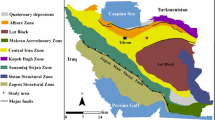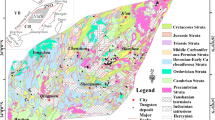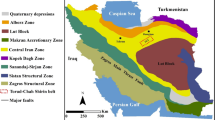Abstract
The prospecting cost–benefit strategy is an easy-to-implement mineral prospectivity modeling algorithm which uses the likelihood ratio, lift index and Youden index to represent the mineral potential. In this study, the prospecting cost–benefit strategy was extended to use the Matthews correlation coefficient (MCC) and F-measure to represent the mineral potential, and compared with the bagging and boosting ensembles of decision stumps in polymetallic prospectivity modeling in the Lalingzaohuo district (Qinghai Province, China). Replacing the decision trees with decision stumps in the bagging algorithm can alleviate the overfitting problem of the bagging ensemble model caused by the depth of the decision trees. According to the polymetallic prospectivity modeling results of the extended prospecting cost–benefit strategy, and bagging and boosting ensembles, seven mineral potential maps were produced, including likelihood ratio map, lift index map, Youden index map, MCC map, F-measure map, classification score maps. The receiver operating characteristic (ROC) curves show that the prospecting cost–benefit strategy is superior to the ensemble learning models in polymetallic prospectivity modeling. According to the seven mineral potential maps, polymetallic prospective areas were optimally delineated in the study area. These polymetallic prospective areas account for only a small percentage of the whole study area (12.61 – 16.95%) but contain almost all known polymetallic deposits (94 – 100%). Therefore, the MCC and F-measure can be used to represent the mineral potential in the prospecting cost–benefit strategy. The extended prospecting cost–benefit strategy performs better than the ensemble learning algorithms in polymetallic prospectivity modeling.

modified from Chen and Wu 2017a)

modified from Chen and Wu 2017a)

modified from Chen and Wu 2017a)

modified from Chen and Wu 2017a)



Similar content being viewed by others
References
Abedi M, Norouzi GH, Bahroudi A (2012) Support vector machine for multi-classification of mineral potential areas. Comput Geosci 46(9):272–283
Agterberg FP (1974) Automatic contouring of geological maps to detect target areas for mineral exploration. Math Geol 6(4):373–395
Agterberg FP (1989) LOGDIA-FORTRAN 77 program for logistic regression with diagnostics. Comput Geosci 15(4):599–614
Agterberg FP, Cheng QM (2002) Conditional independence test for weights-of-evidence modeling. Nat Resour Res 11(4):249–255
Agterberg FP, Bonham-Carter GF (1999) Logistic regression and weights of evidence modeling in mineral exploration. In: Proceedings of the 28th international symposium on applications of computer in the mineral industry (APCOM), Golden, Colorado, pp 483–490
Breiman L (1996) Bagging predictors. Mach Learn 26(2):123–140
Breiman L (2001) Random forests. Mach Learn 45(1):5–32
Carranza EJM, Hale M (2002) Wildcat mapping of gold potential, Baguio district, Philippines. Trans Inst Min Metall Appl Earth Sci 111(2):100–105
Carranza EJM, Laborte AG (2015a) Data-driven predictive mapping of gold prospectivity, Baguio district, Philippines: Application of Random Forests algorithm. Ore Geol Rev 71:777–787
Carranza EJM, Laborte AG (2015b) Data-driven predictive modeling of mineral prospectivity using Random Forests: a case study in Catanduanes Island (Philippines). Nat Resour Res 25:35–50
Carranza EJM, Laborte AG (2015c) Random forest predictive modeling of mineral prospectivity with small number of prospects and data with missing values in Abra (Philippines). Comput Geosci 74:60–70
Carranza EJM, Hale M, Faassen C (2008) Selection of coherent deposit-type locations and their application in data driven mineral prospectivity mapping. Ore Geol Rev 33:536–558
Chen YL (2015) Mineral potential mapping with a restricted Boltzmann machine. Ore Geol Rev 71:749–760
Chen YL, Wu W (2016) A prospecting cost-benefit strategy for mineral potential mapping based on ROC curve analysis. Ore Geol Rev 74:26–38
Chen YL, Wu W (2017a) Mapping mineral prospectivity using an extreme learning machine regression. Ore Geol Rev 80:200–213
Chen YL, Wu W (2017b) Mapping mineral prospectivity by using one-class support vector machine to identify multivariate geological anomalies from digital geological survey data. Aust J Earth Sci 64(5):639–651
Chen YL, Wu W (2019) Isolation forest as an alternative data-driven mineral prospectivity mapping method with a higher data-processing efficiency. Nat Resour Res 28(1):31–46
Chen YL, Zhao QY (2021) Mineral exploration targeting by combination of recursive indicator elimination with the ℓ2-regularization logistic regression based on geochemical data. Ore Geol Rev 135:104213
Chen CH, Dai HZ, Liu Y, He BB (2011) Mineral prospectivity mapping integrating multisource geology spatial data sets and logistic regression modeling. In: Proceedings of IEEE international conference on spatial data mining and geographical knowledge services (ICSDM), pp 214–217
Chen J, Xie ZY, Li B, Li SP, Tan SX, Ren H, Zhang QM (2013a) Geological and geochemical characteristics of the ore-bearing intrusions from the Lalingzaohuo Mo polymetallic deposit and its metallogenic significance. Geology and Exploration 49(5):0813–0824 (In Chinese with English Abstract)
Chen J, Xie ZY, Li B, Tan SX, Ren H, Zhang QM, Li Y (2013b) Petrogenesis of Devonian intrusive rocks in the Lalingzaohuo area, eastern Kunlun, and its geological significance. Journal of Mineral Petrologica 33(2):26–34 (In Chinese with English Abstract)
Chen YX, Pei XZ, Li ZC, Li RB, Liu CJ, Chen GC, Pei L, Wei B (2015) Geochronology, geochemical features and geological significance of the granite gneiss in the Balong area, East Section of East Kunlun. Acta Petrologica Sinica 31(8):2230–2244 (In Chinese with English Abstract)
Chen YL, Wu W, Zhao QY (2019) A bat-optimized one-class support vector machine for mineral prospectivity mapping. Minerals 9:317
Efron B, Tibshirani R (1993) An Introduction to the Bootstrap. Chapman and Hall
Fawcett T (2006) An introduction to ROC analysis. Pattern Recognition Letter 27(8):861–874
Freund Y, Schapire R (1997) A decision-theoretic generalization of on-line learning and an application to boosting. J Comput Syst Sci 55(1):119–139
Geranian H, Tabatabaei SH, Asadi HH, Carranza EJM (2015) Application of discriminant analysis and support vector machine in mapping gold potential areas for further drilling in the Sari-Gunay gold deposit, NW Iran. Nat Resour Res 25:145–159
Han YM, Ma WM, Ma ZM, Ma QL, Ma YL (2015) Metallogenic conditions and polymetallic ore-finding signs of the Lalingzaohuo district in Qinghai Province. Modern Mining 558:128–130 (In Chinese without English Abstract)
Harris D, Pan G (1999) Mineral favorability mapping: a comparison of artificial neural networks, logistic regression, and discriminant analysis. Nat Resour Res 8:93–109
Harris D, Zurcher L, Stanley M, Marlow J, Pan G (2003) A comparative analysis of. favorability mappings by weights of evidence, probabilistic neural networks, discriminant analysis, and logistic regression. Nat Resour Res 12:241–255
Li YC, Li B, Chen J, Zhang QM (2013) Sr-Nd-Pb isotropic characteristics of ore-bearing granodiorites from Lalingzaohuo deposit and its geological significance. Journal of Mineral Petrologica 33(3):110–115 (In Chinese with English Abstract)
Li H, Li XH, Yuan F, Jowitt SM, Zhang MM, Zhou J, Zhou TF, Li XL, Ge C, Wu BC (2020a) Convolutional neural network and transfer learning based mineral prospectivity modeling for geochemical exploration of Au mineralization within the Guandian-Zhangbaling area, Anhui Province, China. Appl Geochem 122:104747
Li S, Chen JP, Xiang J (2020b) Applications of deep convolutional neural networks in prospecting prediction based on two-dimensional geological big data. Neural Comput Appl 32:2037–2053
Li T, Zuo RG, Xiong YH, Peng Y (2021) Random-drop data augmentation of deep convolutional neural network for mineral prospectivity mapping. Nat Resour Res 30:27–38
Lin N, Chen YL, Lai JL (2020) Mineral potential mapping using a conjugate gradient logistic regression model. Nat Resour Res 29(1):173–188
Lu SN (2002) Precambrian geology in northern Tibetan plateau. Geological Publishing House, Beijing, pp 1–125 (In Chinese with English Abstract)
McKay G, Harris JR (2015) Comparison of the data-driven random forests model and a knowledge-driven method for mineral prospectivity mapping: a case study for gold deposits around the Huritz Group and Nueltin Suite, Nunavut, Canada. Nat Resour Res 25:125–143
Mejia-Herrera P, Royey JJ, Caumon G, Cheilletz A (2015) Curvature attribute from surface-restoration as predictor variable in Kupferschiefer copper potentials. Nat Resour Res 24(3):275–290
Nykänen V, Groves DI, Ojala VJ, Gardoll SJ (2008) Combined conceptual/empirical prospectivity mapping for orogenic gold in the northern Fennoscandian Shield, Finland. Aust J Earth Sci 55(1):39–59
Qi SS, Deng JF, Ye ZF, Liu R, Wang GL (2013) LA-ICP-MS Zircon U-Pb dating of Late Devonian diabase dike swarms in the Qimantage area. Geol Bull China 32(9):1385–1393 (In Chinese with English Abstract)
Rodriguez-Galiano VF, Chica-Olmo M, Chica-Rivas M (2014) Predictive modelling of gold potential with the integration of multisource information based on random forest: a case study on the Rodalquilar area, Southern Spain. Int J Geogr Inf Sci 28:1336–1354
Wang FC, Chen J, Xie ZY, Li SP, Tan SX, Zhang YB, Wang T (2013) Geological features and Re-Os isotropic dating of the Lalingzaohuo molybdenum polymetallic deposit in East Kunlun. Geology in China 40(4):1209–1217 (In Chinese with English Abstract)
Xiong YH, Zuo RG, Carranza EJM (2018) Mapping mineral prospectivity through big data analytics and a deep learning algorithm. Ore Geol Rev 102:811–817
Zhang ZJ, Zuo RG, Xiong YH (2016) A comparative study of fuzzy weights of evidence and random forests for mapping mineral prospectivity for skarn-type Fe deposits in the southwestern Fujian metallogenic belt, China. Sci China Earth Sci 59(3):556–572
Zhao ZM, Ma HD, Wang BZ, Bai YS, Li RS, Ji WH (2008) The evidence of intrusive rocks about collision-orogeny during Early Devonian in Eastern Kunlun area. Geol Rev 54(1):47–56 (In Chinese with English Abstract)
Zhu J, Zou H, Rosset S, Hastie T (2009) Multi-class AdaBoost. Stat Interface 2:349–360
Zuo R, Carranza EJM (2011) Support vector machine: a tool for mapping mineral potential. Comput Geosci 37:1967–1975
Zuo R, Kreuzer OP, Wang J, Xiong Y, Zhang Z, Wang Z (2021) Uncertainties in GIS-based mineral prospectivity mapping: key types, potential impacts and possible solutions. Nat Resour Res. https://doi.org/10.1007/s11053-021-09871-z
Acknowledgements
This work was supported by National Natural Science Foundation of China (Grant no. 41872244).
Author information
Authors and Affiliations
Corresponding authors
Additional information
Communicated by: H. Babaie
Publisher's note
Springer Nature remains neutral with regard to jurisdictional claims in published maps and institutional affiliations.
Rights and permissions
About this article
Cite this article
Chen, Y., Zhang, Y. & Tan, Y. A comparative study of the cost–benefit strategy with the learning ensembles of decision stumps in polymetallic prospectivity modelling. Earth Sci Inform 15, 57–72 (2022). https://doi.org/10.1007/s12145-021-00709-z
Received:
Accepted:
Published:
Issue Date:
DOI: https://doi.org/10.1007/s12145-021-00709-z




